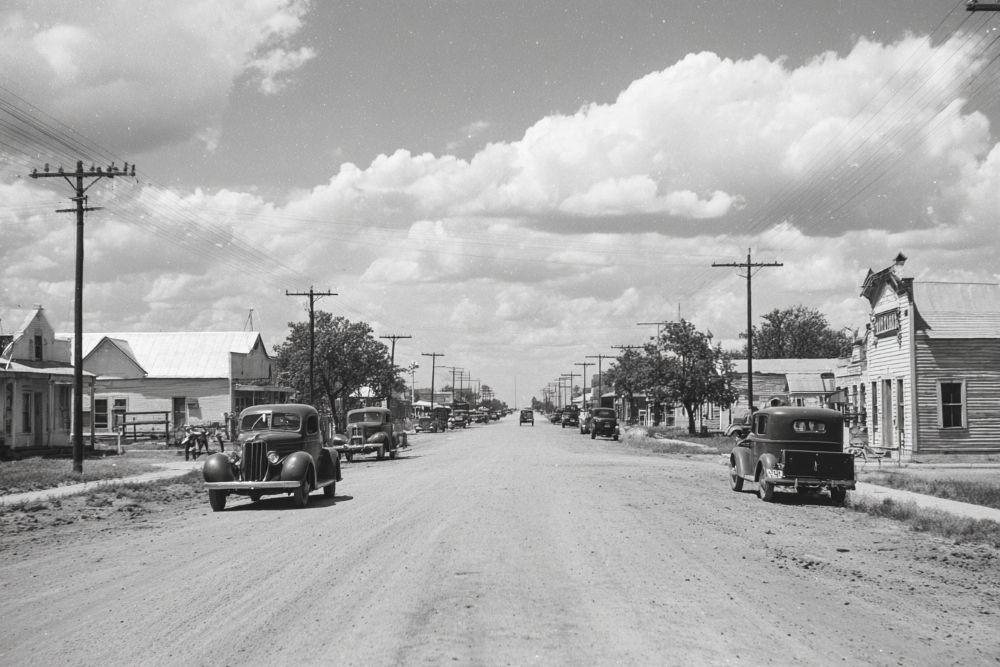
Jackson Massacre. Settlers Moses and Lydia Jackson set out one morning in October of 1858 with four of their seven children to spend the day with friends. As they neared their destination they encountered a small party of Indians, possibly Comanches. Louis and I. J. Jackson and their parents were killed immediately. The two middle children, Joshua and Rebecca, were abducted, only to be abandoned after almost two weeks. They walked for two days before being recovered by a search party of settlers and Texas Rangers near Sweetwater. The Jackson family was buried where they fell, a short distance from this site. Historical Marker erected in 1998. Marker located 14.2 mi. W of Goldthwaite on FM 574; 3.3 mi. NW of FM 573.
The Old Town Well. Mr. Peyton died from poison fumes in digging this well; Ben Cox was also overcome; Deed H. Mayer rescued Mr. Cox and brought up Mr. Peyton's body; August 1887. In memory of these three men; Mills Co. Hist. Society. Historical Marker erected in 1963 on the Courthouse Square, Highway 183, Goldthwaite.
The Goldthwaite Eagle. In 1885 William H. Thompson (1842-1896) started a weekly newspaper, "The Mountaineer", which closed but was reestablished in 1894. He sold it in 1896 to R. M. Thompson, his nephew, who renamed it "The Goldthwaite Eagle". At that time eagles still lived in the hills of Mills County. The paper was bought in 1920 by Dr. E. M. Wilson. It changed hands between the Wilson and Thompson Families until 1950, when Charlie T. Wilson sold it to H. R. Ekins. A merger with "The Mullin Enterprise" made it the county's only newspaper. In 1971 Frank Bridges purchased "The Eagle" from Victor E. Koleber. Historical marker erected 1977. Marker located at 5th and Fisher, across from courthouse square.
Mills County State Bank. Mills County experienced much growth from 1887 to 1917 after the establishment of the Gulf, Colorado, and Santa Fe railway in the region. As Goldthwaite became the county seat and center, locals saw the need for a bank. On June 4, 1888, D. H. Trent opened a private bank on the east corner of Fisher at 4th streets with deposits of $4,168.61 and stock account of $11,449.50. Four years later, First National Bank of Goldthwaite was organized with W.E. Miller as president. The stockholders of the bank voted to liquidate in 1901, and the building along with the furniture was sold to Trent. In 1908, Charter No. 369 was granted at the first meeting of the stockholders of Trent State Bank under which the bank operates today. Trent State Bank was located on the west corner of the same intersection of Fisher at 4th streets. Directors voted on January 29, 1952 to change the name to Mills County State Bank. In 1960, the board of directors made plans for the building of modern banking quarters. The new facilities, which included a drive thru lane, were constructed at 1017 Parker Street. On October 10, 2008, staff, officers, directors, stockholders, many banking dignitaries, friends and customers of the bank attended a celebration at mills county state bank that marked 120 years in banking and 100 years as a state chartered bank. Over the years, the bank has expanded, modernized, and opened other offices in Brownwood, Early, and Hamilton. It is commended for its perseverance through difficult times and is considered a loyal advocate of the communities it serves. Historical Marker erected in 2011. Marker located on corner of Parker and Fourth Streets, Goldthwaite.
First Methodist Church of Goldthwaite. Goldthwaite Methodists trace their history to the mid-1850s, when circuit-riding preachers began traveling to the area to minister to early permanent settlers. The pioneers gathered for services in private homes, out of doors, or in a one-room schoolhouse. For a time they were led by The Rev. H. Childress, who was known as the "bear-hunting preacher" because of the firearms he carried for protection while traveling. In 1885, the Santa Fe Railway founded the town of Goldthwaite. The town's railroad crew and passengers formed a ready market for goods and services, attracting new residents, who formed a local congregation of the Methodist Episcopal Church, South, that year. The Rev. C. V. Oswalt was the first pastor, and within two years the congregation completed its first church structure, a wood frame building. Since that time, the congregation has built several progressively larger church structures to accommodate its growth. Due to denominational mergers, the congregation changed its name to the First Methodist Church in 1939, and to the First United Methodist Church in 1968. Active in missionary and social service since its beginning, the First Methodist Church remains an important part of the religious life of this community. - Historical marker located 1011 Hutchins Street, Goldthwaite.
Goldthwaite Memorial Cemetery In 1888, three local men bought land for use as a cemetery; the first burial was that of Houston Roberts. The Odd Fellows Lodge bought the grounds in 1894, adding land over the years. Watson Whittaker was killed during an 1898 train robbery and made headlines as a funeral train brought him to Mills County for burial here. The lodge sold the cemetery in 1943 to the city, and it became Goldthwaite Memorial Cemetery. Local groups made improvements and placed memorials to honor the sacrifice of area veterans buried here. Today, the cemetery provides a link to area history. Historic Texas Cemetery - 2002
Goldthwaite, TX 31° 26' 59.5896" N, 98° 34' 15.1536" W
See map: Google Maps, Yahoo! Maps, MapQuest





























